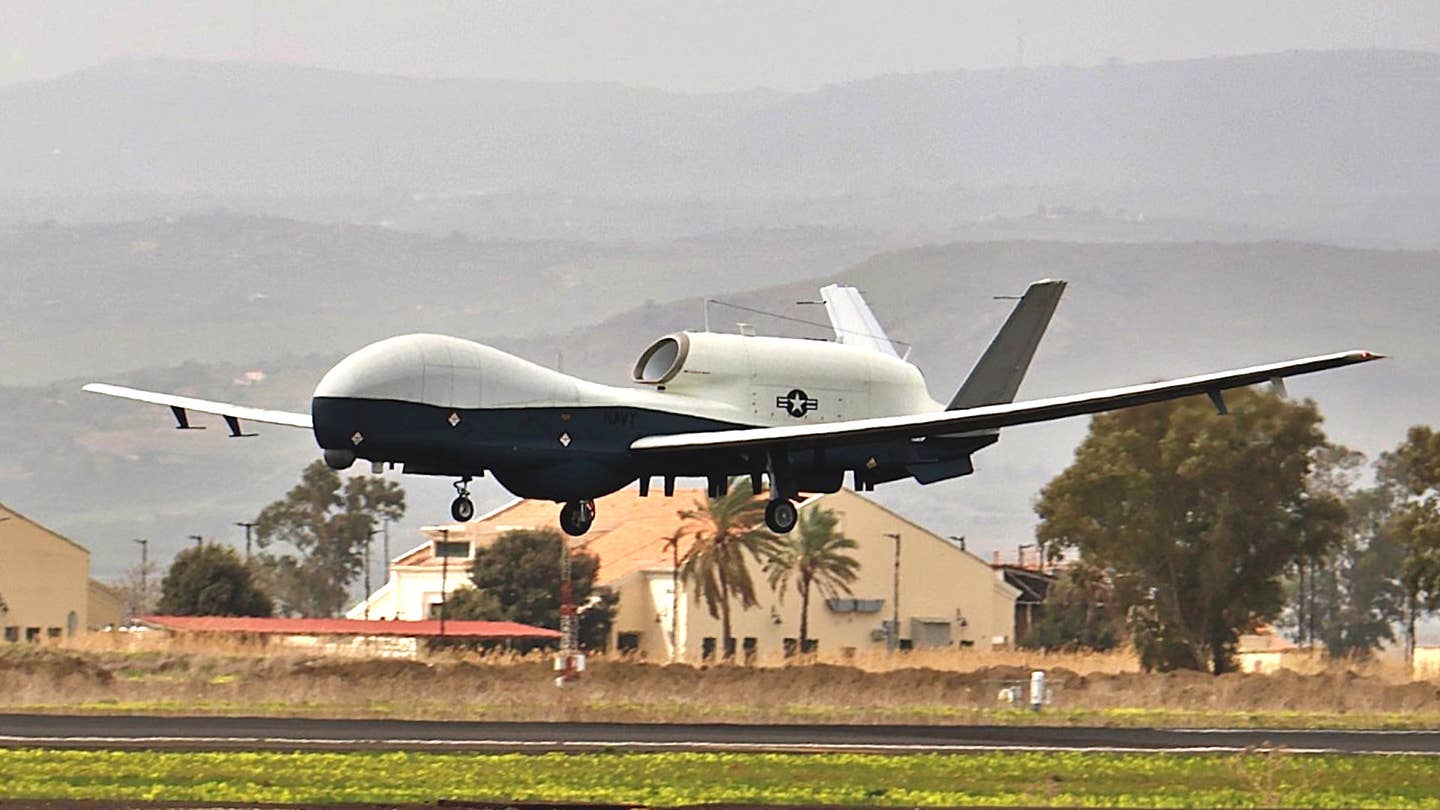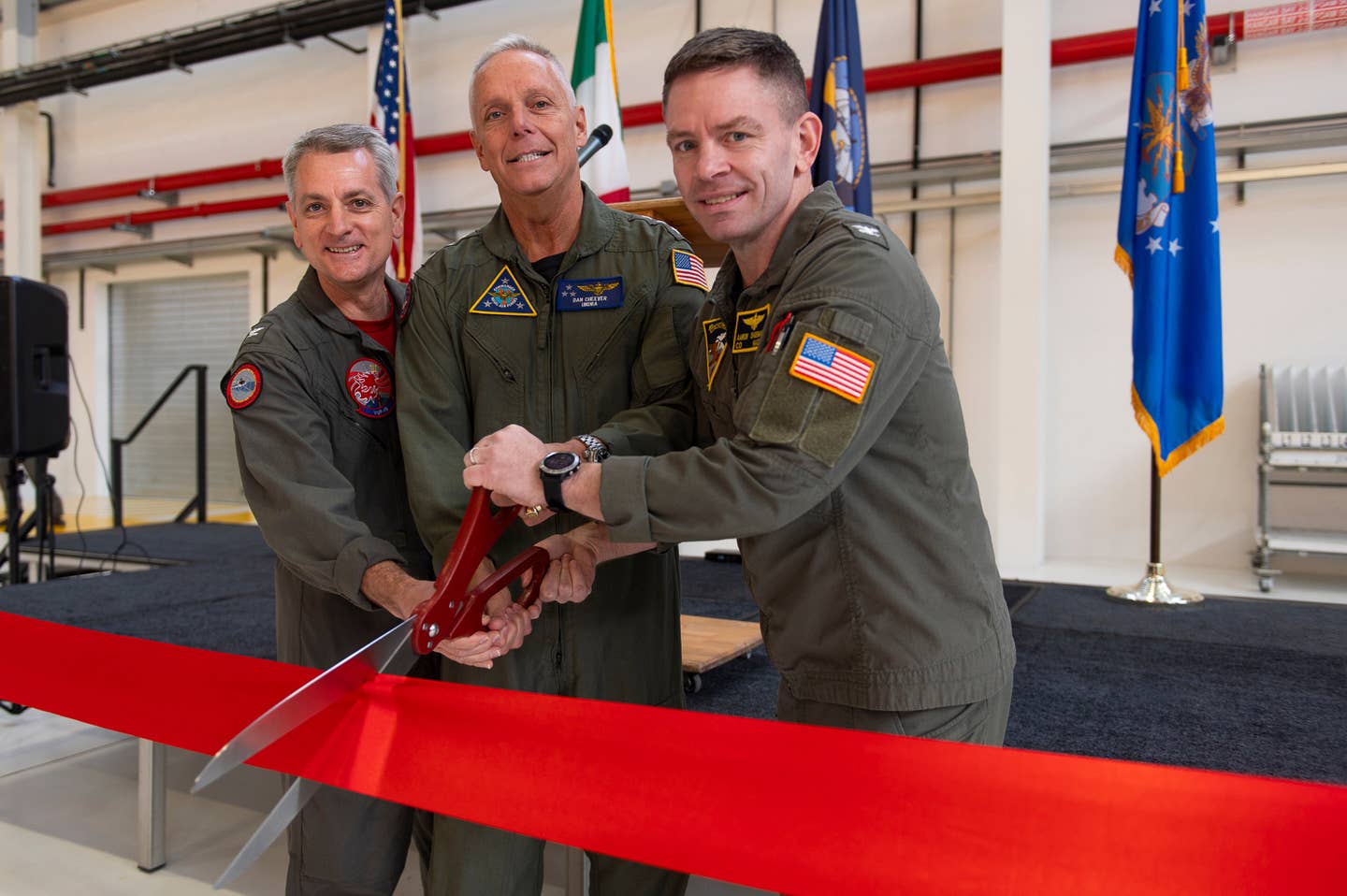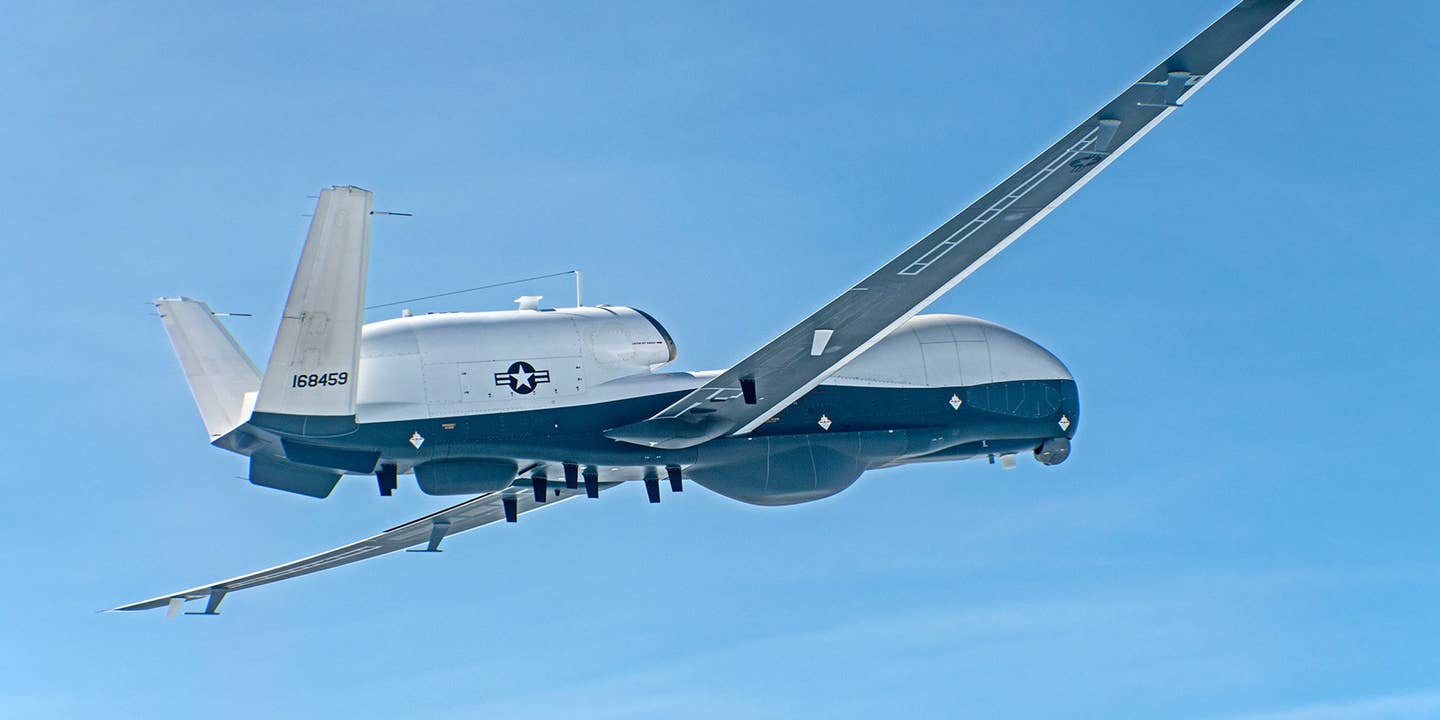
Summary - MQ-4C Triton Operations
1. On June 2nd, 2024, a U.S. Navy MQ-4C Triton drone (reg. 169660, callsign BLACKCAT6) conducted extensive surveillance off the coast of Libya, particularly near Tripoli and Misrata. It flew intricate search patterns at 48,100 feet.
2. The first MQ-4C forward deployed to Naval Air Station Sigonella in Sicily, Italy arrived on March 30, 2024. It is operated by Unmanned Patrol Squadron 19 (VUP-19).
3. From Sigonella, Tritons can provide valuable ISR coverage over the Mediterranean, Black Sea, North Africa and Middle East. A new hangar was opened at Sigonella in March 2024 to support MQ-4C operations.
4. On April 17, 2024, the Triton flew its first mission from Sigonella, orbiting in international waters between Libya and Crete, possibly monitoring reported Russian weapon shipments from Syria to eastern Libya.
5. The MQ-4C joins U.S. Air Force RQ-4As and NATO RQ-4Ds already based at Sigonella. The Tritons provide additional maritime surveillance capabilities.
6. The U.S. Navy has significantly scaled back its MQ-4C acquisition plans from Northrop Grumman from 70 to 27 drones, following the 2019 shoot-down of an older RQ-4 drone by Iran which raised questions about their vulnerability.
In summary, the deployment of the advanced MQ-4C Triton to Sigonella expands the U.S. Navy's ISR reach over strategically important waters around Europe, North Africa and the Middle East, although the long-term plans for the Triton fleet have been reduced.
Surveillance Activity of Northrop Grumman MQ-4C Triton Off Libya – ItaMilRadar
On June 2nd, 2024, an interesting aerial operation was tracked off the coast of Libya. The aircraft in question, a USNavy Northrop Grumman MQ-4C Triton ( reg. 169660 – callsign BLACKCAT6), conducted a series of intricate flight patterns over the Mediterranean Sea off eastern and, in particularly, off western Libya.

The MQ-4C Triton, operated by the United States Navy, is a high-altitude, long-endurance unmanned aerial vehicle (UAV) designed for surveillance and reconnaissance missions.
The image shows BLKCAT6 performing a detailed and extensive search pattern at an altitude of 48,100 feet. With a ground speed of 247 knots, the UAV methodically covered a significant area, likely engaged in intelligence-gathering activities. The MQ-4C Triton, with registration number 169660, has been in service for a year as of January 2023. This particular model is part of the U.S. Navy’s strategic assets for maritime surveillance.
The flight path of BLKCAT6, as depicted in the image, suggests a focused surveillance operation. The looping and circling patterns are typical of reconnaissance missions aimed at gathering detailed imagery or signals intelligence over a specific area. The area of operation, just north of the Libyan coast near Tripoli and Misrata, is of strategic importance, given the ongoing geopolitical tensions and security concerns in the region.
This particular flight highlights the continued presence and surveillance efforts of the U.S. Navy in the Mediterranean region. The MQ-4C Triton, with its state-of-the-art technology, plays a critical role in maintaining situational awareness and enhancing the security of maritime routes.
MQ-4C Triton Has Arrived In Europe, Could Impact Black Sea, Red Sea Operations
The global operational reach of the U.S. Navy's MQ-4C Triton fleet has expanded again with the arrival of one of the drones, which are optimized for long-duration overwater missions, at Naval Air Station Sigonella in Italy. From Sigonella, Tritons will be able to provide valuable additional intelligence, surveillance, and reconnaissance coverage over and around parts of Europe, especially for keeping tabs on activity in the Mediterranean Sea and the Black Sea, as well as North Africa and the Middle East. At the same time, this all follows the Navy's decision to significantly scale back its plans for the MQ-4C.
The first MQ-4C to be forward deployed at Naval Air Station (NAS) Sigonella arrived at the base on Italy's island of Sicily on March 30. The Triton is from Unmanned Patrol Squadron 19 (VUP-19), which has its main base of operations at Naval Air Station Jacksonville in Florida. VUP-19, which also has a detachment at Point Mugu in California, is currently the Navy's only operational MQ-4C squadron. The service does plan to establish a second such unit, VUP-11, in the 2026 Fiscal Year. Air Test and Evaluation Squadron 20 (VX-20) at NAS Patuxent River also has a Triton for test and evaluation use.

Plane spotters using online flight tracking software first noticed the MQ-4C heading from Jacksonville toward Europe on March 29. VUP-19 now has two forward-deployed detachments outside of the continental United States, the other being at Andersen Air Force Base on Guam. VUP-19 Tritons at Andersen have also conducted temporary deployments to Japan. The Navy plans to establish a third VUP-19 detachment, but where it might be based is unclear.
MQ-4C 169659 departed from NAS Mayport around 03/29 18:30 UTC as TRITON16. 6 hours later, it reappeared over the North Atlantic with callsign VVPE659, headed towards Europe. This is the first time I have seen an MQ-4C in this area. #ADSB #AE7812
What’s with the MQ-4C Triton doing in the middle of the North Atlantic about 2/3rd to Europe off the coast of Africa? Anyone ever observe one out here before? Time: 01:45z Hex: #AE7812 Callsign: #VVPP659 Reg: 169659 Type: Q4
Earlier in March, the Navy held a ceremony to mark the opening of a new hangar at Sigonella specifically designed to house MQ-4Cs. The Triton is a derivative of the RQ-4 Global Hawk high-altitude long-endurance drone that has been optimized for persistent, over-water missions, which Australia is also in the process of acquiring. Other variants and derivatives of the Global Hawk are in service today with the U.S. Air Force, South Korea, and Japan, as well as with a unit operated collectively by multiple members of the NATO alliance.

Compared to the original RQ-4A, the MQ-4C notably has a strengthened fuselage and reinforced wings, as well as additional features to help prevent the build-up of ice on the leading edges and around the air intake and improve its ability to withstand lightning strikes. These changes give the Triton the ability to swoop down to lower altitudes to more closely investigate objects of interest on the surface.
As originally designed, the MQ-4C's sensor suite included an active electronically scanned radar with surface search and synthetic aperture modes, electro-optical and infrared video cameras in a turret under the nose, and electronic support measures systems for collecting electronic intelligence passively. In recent years, manufacturer Northrop Grumman has started delivering upgraded Tritons to the Navy in a so-called Multi-Intelligence (Multi-Int) configuration with additional electronic and signals intelligence (ELINT/SIGINT) capabilities. Tritons are also intended to work very closely together with Navy P-8A Poseidon maritime patrol and surveillance aircraft and aircraft carrier strike groups.

"In the interest of operational security, we cannot comment on details of future operations and deployments, but can say that U.S. Sixth Fleet is committed to supporting U.S., Allied and partner interests in the region, and the deployment of the MQ-4C Triton gives us the opportunity to increase interoperability and enhance the combined capabilities amongst our NATO Allies and partners," a spokesperson for U.S. Naval Forces Europe-Africa (NAVEUR-NAVAF) told The War Zone.
U.S. Sixth Fleet is the numbered U.S. Navy fleet associated with U.S. Naval Forces Europe-Africa (NAVEUR-NAVAF), which oversees all of the service's operations in and around Europe and Africa, and commands are often referred to collectively.
“The addition of the MQ-4C Triton, right here in Sigonella, is another milestone in the successful development of the Triton program,” Navy Capt. Aaron Shoemaker, NAS Sigonella's commanding officer also said in a statement. “We are proud to support VUP-19 as they integrate with the Fleet to expand the roles of unmanned aircraft systems operations in our region and beyond.”
Sigonella has been a key strategic staging point for U.S. military crewed and uncrewed operations in this part of the world for decades. The Navy's MQ-4C joins Air Force RQ-4As and NATO RQ-4Ds already at the base on Sicily. Global Hawks have been particularly active in and around the Black Sea since the run-up to Russia's all-out invasion of Ukraine in 2022. RQ-4s and other drones, as well as crewed intelligence, surveillance, and reconnaissance (ISR) aircraft have continued to fly over that body of water regularly since then, gathering intelligence that can be disseminated, and, in some cases, forwarded to Ukrainian authorities.
Outside of the ongoing conflict in Ukraine, the Black Sea, as well as the Mediterranean, have long been very strategic maritime regions where the U.S. military has high demands for routine ISR coverage. Air Force RQ-4s have used their very long endurance and other capabilities to help provide important ISR coverage elsewhere in Europe over the years, too. With their over-water and maritime surveillance capabilities, Navy MQ-4Cs could be particularly useful for flights over other strategic bodies of water around Europe further to the north, where Russian activity is also often a concern.
The RQ-4s in service with the Air Force today have much more limited sensor suites compared to those found on MQ-4Cs, in addition to their overall design not being optimized for maritime operations. Altogether, Navy Tritons will provide U.S. commanders in Europe significant additional capabilities over what is currently provided by Global Hawk.
In addition to supporting operations in Europe, Sigonella offers a prime location for launching ISR aircraft like Tritons on sorties around potential hotspots in Africa and the Middle East.
Navy P-8As have been routinely flying in the Eastern Mediterranean off the coasts of Israel and the Gaza Strip since the conflict erupted there last October. Aerial overwatch is only set to become more important in that context as the U.S. military works to establish a temporary offshore pier to increase the flow of humanitarian aid into Gaza. There continue to be questions and concerns about risks to U.S. forces and how exactly security will be provided in the course of that operation, which you can read more about here.
From Sigonella, Navy MQ-4C could fly to the Red Sea and even further south, areas where Iranian-backed Houthi militants in Yemen have been launching regular attacks on U.S. and other foreign warships, as well as commercial vessels. Tritons could help provide additional situational awareness and support strikes on Houthi weapons and other assets ashore.
Navy Triton operations already benefit directly from experience gained over more than a decade of operating older Global Hawk variants over and around the Persian Gulf. Between 2009 and 2022, the Navy flew a small fleet of early-generation Block 10 RQ-4As in the maritime surveillance role from Al Dhafra Air Base in the United Arab Emirates (UAE). This was part of a program called the Broad Area Maritime Surveillance Demonstrator (BAMS-D), which lasted much longer than expected and fed directly into the development of the MQ-4C and of tactics, techniques, and procedures for operating those drones. You can read more about BAMS-D here.
At the same time, BAMS-D also looks to have been a contributing factor in the Navy's decision to significantly truncate its plans for the MQ-4C, despite Triton's still-growing operational footprint outside of the continental United States. In 2019, Iranian forces shot down one of the BAMS-D drones while it was flying over the Strait of Hormuz, which links the Persian Gulf and the Gulf of Oman. This in turn immediately prompted a very public debate about the vulnerability of Global Hawks and their derivatives, especially in a potential future high-end conflict against a near-peer competitor like China.
In 2022, the Navy decided to dramatically truncate its total planned purchases of MQ-4Cs from 70 to 27. This figure includes an MQ-4C that was lost in a crash in 2018, as well as one drone retained for testing, according to a declassified Pentagon Selected Acquisition Report (SAR).
What all of this might mean for the future service career of the Navy's MQ-4Cs remains to be seen. Whatever the case, Tritons based at NAS Sigonella will now be able to additional ISR capacity over and around parts of Europe, Africa, and the Middle East.
US Navy 'Unleashes' Cutting-Edge MQ-4C Triton UAV In Europe; Here Is What Makes It 'Best In Business'
In a major development marking a stride in maritime surveillance capabilities, the US Navy has initiated operations of its Northrop Grumman MQ-4C Triton Broad Area Maritime Surveillance (BAMS) in the European theatre.
According to online flight tracking services, the UAV departed Naval Air Station (NAS) Sigonella in Sicily on April 17 for its first sortie.
The confirmation of the deployment comes approximately two weeks after the US Navy disclosed in late March that the initial MQ-4C Triton had arrived in the Sixth Fleet area of operations.
The Sixth Fleet, associated with US Naval Forces Europe-Africa (NAVEUR-NAVAF), manages naval activities in and around Europe and Africa and oversees strategic commands within the region.
Flight tracking data revealed that the MQ-4C Triton conducted its mission in the Mediterranean, specifically off the coast of Libya. The unmanned aircraft was observed orbiting in international waters between Libya and Crete, potentially monitoring activities in eastern Libya.
Speculation suggested that the mission’s focus might have been on monitoring shipments of weapons reportedly conducted by Russia from the Syrian port of Tartus to Tobruk in eastern Libya. However, so far, the US Navy has not released an official statement regarding the specifics of the mission.
The MQ-4C Triton deployed to NAS Sigonella arrived on March 30, with preparations for its arrival including a ceremony held by Unmanned Patrol Squadron 19 (VUP-19) “Big Red” on March 2 to commemorate the deployment and the opening of a new Triton hangar at the base.
VUP-19, based at Naval Air Station Jacksonville in Florida, is the Navy’s sole operational MQ-4C squadron, with a detachment also located at Point Mugu in California. Plans, however, are in place to establish a second unit, VUP-11, in the 2026 Fiscal Year.
The deployment of the MQ-4C Triton to Sigonella holds strategic significance, as the base has long served as a crucial staging point for US military operations in the region. NAS Sigonella is already home to Air Force RQ-4As and NATO RQ-4Ds, bolstering surveillance capabilities in the area.
The introduction of the MQ-4C Triton has added another layer to the surveillance efforts, particularly in light of increased activity in the Black Sea region since Russia invaded Ukraine in 2022. The deployment underscores the US Navy’s efforts to enhance its intelligence, surveillance, and reconnaissance capabilities in Europe and Africa.
The installation’s strategic positioning facilitates the deployment and response of US, allied, and partner nation forces as necessary, thereby guaranteeing security and stability across Europe, Africa, and Central Command.
Northrop Grumman MQ-4C Triton
The MQ-4C Triton, a derivative of the RQ-4 Global Hawk high-altitude long-endurance drone, is a crucial asset for maritime surveillance operations. Developed by Northrop Grumman, the Triton has been optimized for persistent over-water missions and showcases enhanced capabilities tailored for naval operations.
Distinguishing itself from its predecessor, the RQ-4A, the MQ-4C Triton boasts a reinforced fuselage and wings, along with advanced features to mitigate ice build-up and improve resilience against lightning strikes.
These enhancements enable the Triton to descend to lower altitudes for closer examination of surface targets, augmenting its surveillance capabilities.
Equipped with a sophisticated sensor suite, the MQ-4C Triton originally featured an active electronically scanned radar, electro-optical and infrared video cameras, and electronic support measure systems.
However, recent advances have seen Northrop Grumman delivering upgraded Tritons to the Navy in a Multi-Intelligence (Multi-Int) configuration. This configuration integrates additional electronic and signals intelligence (ELINT/SIGINT) capabilities, augmenting the Triton’s versatility and efficacy in surveillance operations.
Moreover, the US Navy’s extensive experience with older Global Hawk variants has significantly influenced the development and operational tactics of the MQ-4C Triton.
Operating Block 10 RQ-4As from Al Dhafra Air Base in the United Arab Emirates (UAE) between 2009 and 2022, the US Navy gleaned invaluable insights into maritime surveillance, contributing to the refinement of Triton operations.
Additionally, Triton operations are integrated with Navy P-8A Poseidon maritime patrol and surveillance aircraft, as well as aircraft carrier strike groups.
This collaborative approach enhances maritime domain awareness and enables synchronized operations across naval assets, bolstering the US Navy’s ability to monitor and respond effectively to maritime threats.
Beyond its deployment with the US Navy, the MQ-4C Triton garners international attention. Australia is in the process of acquiring this high-altitude, long-endurance unmanned aerial vehicle. Additionally, variants of the Global Hawk platform are operational with South Korea, Japan, the US Air Force, and NATO alliance members.
- Contact the author at ashishmichel(at)gmail.com
- Follow EurAsian Times on Google News



No comments:
Post a Comment